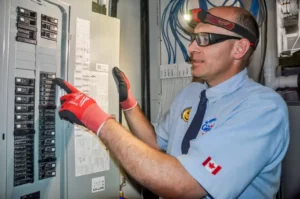
Same Day Service
Since 2001
Call The Gentleman Pros Now!
(587) 797-2979

Properly working circuit breakers are a crucial part of your home’s electrical safety system. Their job is to feed electricity to each of the branch circuits and immediately turn off the supply of electricity to the circuit when they detect a problem.
“On time pleasant fellows. There were 3. Were thorough in advising of any issue and various solutions. Prices quoted had options to choose based on budget and future considerations. Explained all service and operating of parts. I have used this company to do yearly inspections plus a few emergency situations over the years and am totally happy with the service.Does not push suggested work to be done. Offer more than one year labour warranty for work done. Plus they now offer electrical inspections and service. Will continue using as qualified good value for service” Debora D

So even though you probably want to rip your hair out every time a circuit breaker trips (why don’t they ever trip during a convenient time?), it is doing its job and keeping you and your family safe from misbehaving electricity.
It is important you make sure your circuit breakers are always at the top of their game. And if they aren’t, you need to get them fixed pronto!
Signs you need to call an electrician to look at your circuit breakers are:
A couple of other but less urgent reasons to have an electrician look at your circuit breakers are:
These may not actually be problems with your circuit breaker but they do indicate you may need new or more circuit breakers.
Our accredited electricians are more than skilled and knowledgeable to take care of all your electrical needs, including diagnosing problems with your circuit breakers and repairing and upgrading them to make sure they meet your household’s electrical needs.
We put our electricians through a detailed vetting process to make sure that they are not only qualified but that they are honest and trustworthy. We understand you are inviting a stranger into your home to do this work and this can be unsettling. So we do everything in our power to make sure we are hiring quality humans who are also excellent electricians, including running a criminal record check and doing drug testing.
Let us alleviate your worry and give us a call. Our customer care agents love making our customers smile and are available 24/7 for your call.
You can contact us by calling (403) 755-4914, filling out our online form, or chatting with us by clicking on the red “Chat With Us” bubble located in the right-hand bottom corner of this page.
There are different types of standard circuit breakers.
Single-pole circuit breakers supply electricity to their circuit and turn off the electricity when it detects an overload/overcurrent or short circuit in the circuit. They attach to one of the two bus bars (or poles) in the electrical panel and supply 120V and 15-20 amps of electricity to their branch circuit.
They have one hot wire leaving the breaker and one neutral wire coming back to the neutral bus bar.
They control the electricity to the circuits that provide power to your standard lighting and outlet circuits and to some circuits that carry power to appliances. Most of the circuit breakers in your electrical panel will be single-pole circuits.
Double-pole circuit breakers provide the same function as a single-pole breaker but attach to both bus bars (or poles) on the electrical panel and supply 240V and 20-60 amps of electricity to their branch circuit. They are basically two single-pole breakers wired together.
They have two hot wires attached to the circuit breaker and one neutral wire attached to the neutral bus bar. Sometimes a 240 V circuit doesn’t require a neutral wire. For example, 240 V baseboard heaters and air conditioners don’t need a neutral wire to complete their circuit.
Double-pole circuit breakers are used on branch circuits that need more electricity than the amount supplied by a single-pole breaker. These circuits provide power to high-energy usage appliances like your dryer or air conditioning unit.
Tandem circuit breakers are specialty breakers that supply and monitor electricity on two different circuits in the space for a single-pole breaker.
They are the same size as a single-pole breaker but they contain two smaller breakers. Each of these smaller breakers has its own switch and monitors and supplies 120 V of electricity to its own branch circuit
Each electrical panel has a limited number of single-pole breaker slots. Tandem breakers are used when circuits have been added and there isn’t enough space to use single-pole breakers.
Tandem breakers are not always allowed and some electrical panels are not designed to use them. So, please check with a local electrician to find out if you can safely install tandem breakers.
They are also called split, double, or twin breakers.
Ground Fault Circuit Interrupter (GFCI) breakers provide the same benefits as standard circuit breakers but they also help protect you and your family from electric shock.
They are designed to shut off power when they find a ground fault (unstable current) on the circuit. An unstable current often means electricity is travelling outside its designed circuit and means you are at risk of getting a shock.
They are similar to GFCI outlets, but instead of just monitoring and stopping electricity to one outlet, a GFCI breaker monitors everything on one circuit (outlets, switches, fixtures, etc.) and turns off electricity to everything on that circuit when it detects an unstable current.
They come in both single-pole and double-pole versions.
Arc Fault Circuit Interrupters (AFCI) circuit breakers perform the same functions as standard circuit breakers but have an additional safety feature. They also detect arcing and will stop the flow of electricity if they determine the arcing is too dangerous.
In addition to helping to prevent electrical shocks, an AFCI breaker helps prevent fires.
They come in both single-pole and double-pole versions.
Combination Arc Fault Circuit Interrupter (CAFCI) breakers protect the circuit from the same arcing as AFCI breakers and they also protect the circuit from low-energy series arcing.The Canadian Electrical Code now requires AFCI circuit breakers instead of AFCI breakers.
GFCI/AFCI breakers provide the functions of both GFCI and AFCI breakers in one circuit breaker. And they are preferable to a standard AFCI breaker because CAFCI breakers are prone to “nuisance tripping” or tripping for no reason.
The above is provided as information only, not as advice. Regulations and codes vary from jurisdiction to jurisdiction. Please check the applicable electrical code for your area or contact a local electrician before doing any electrical work.



